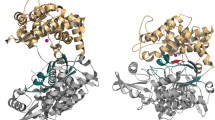Abstract.
Paecilomyces carneus carboxypeptidase sequentially liberated amino acids from the carboxy-terminus of neurotensin, angiotensin I, bradykinin, and delta sleep-inducing peptide, indicating that the sequential hydrolysis of peptides was limited by the occurrence of intermediates with the structure of -Gly-X (X = L-amino acid), -Pro-X, -X-Gly, and -X-Pro. The enzyme had carboxyamidase and/or amidase activities for the carboxy-terminally amidated peptides. The enzyme essentially acted as a carboxyamidase for the long carboxy-terminally amidated peptides; an amidase became dominant for the substrates in the presence of bulky amino acids such as Arg, Met, Leu, and Phe in the penultimate (P1) and P2 positions, corresponding with the S1 and S2 sites of the enzyme, and the P3 position of carboxy-terminally amidated peptides played a significant role in the action as a carboxyamidase or a amidase.
Similar content being viewed by others
Author information
Authors and Affiliations
Additional information
Received: 10 June 1997 / Accepted: 14 July 1997
Rights and permissions
About this article
Cite this article
Umetsu, H., Hishinuma, K., Wake, H. et al. Action of Serine Carboxypeptidase from Paecilomyces carneus on Oligopeptides Containing Carboxy-Terminally Amidated Peptides. Curr Microbiol 36, 41–44 (1998). https://doi.org/10.1007/s002849900277
Issue Date:
DOI: https://doi.org/10.1007/s002849900277



